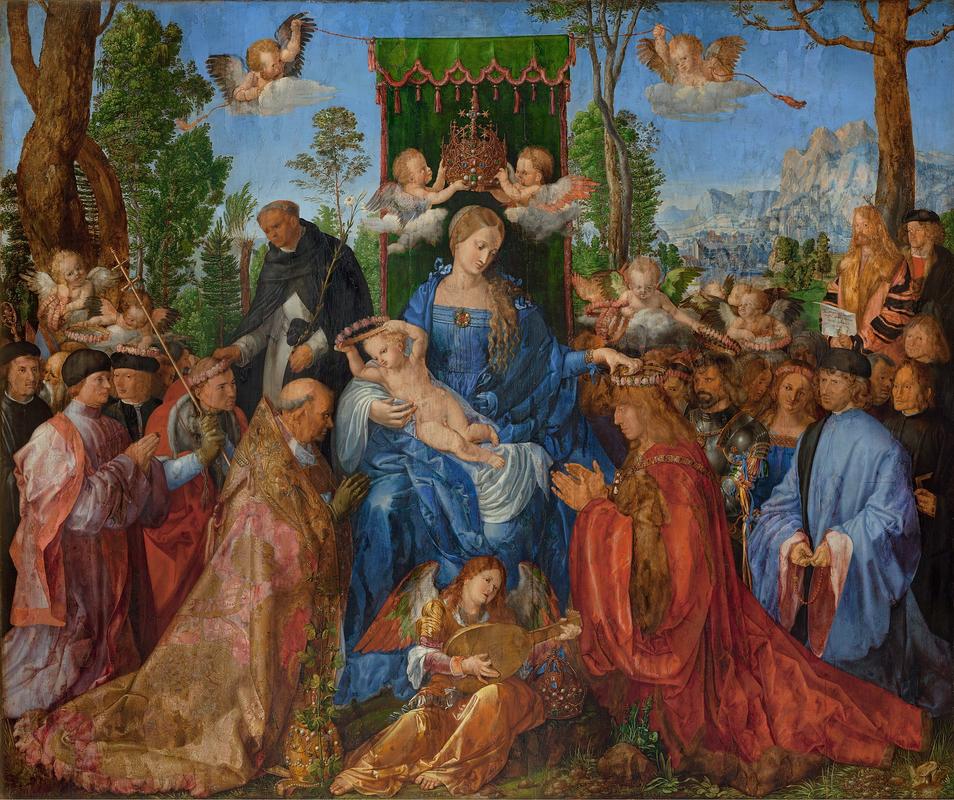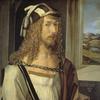More about Feast of the Rose Garlands

Contributor
515 years ago, Dürer visited the Republic of Venice, where a group of German merchants at the Fondaco dei Tedeschi, a big communal building, commissioned him to make the Feast of the Rosary.
The painting depicts the brotherhood of the rosary, or the Confraternity of the Most Holy Rosary, a Roman Catholic Archconfraternity which aims to say the prayers of the entire Holy Rosary every week. The Rosary, with a capital R, refers to the corresponding prayer books, while the rosary with a small r denotes the prayer beads used by adherents to the faith, which the man kneeling in blue on the right side of this image is holding. The rosary is analogous to the Hindu japamala, the Muslim misbaḥah or tasbīḥ, or Buddhist prayer beads.
Anja Grebe's research shows that Dürer had to take a break from this work for health reasons, an act of restraint which probably could have saved the life of Raphael (the painter, not the Teenage Mutant Ninja Turtle, who is alive and well.) When he looked at it with new eyes after some much-needed Venetian R&R, Dürer was happy with his work, writing to his friend, Willibald Pirckheimer that, "No image of Mary in the entire country is better than mine." Despite an extremely rough five hundred years of life for this Mary, many scholars today still agree with him. Over the centuries, people have made prints and other reproductions of this work for study, meditation, and conservation. Some of the people making reproductions decided that Dürer's uniquely realistic detail, like including a fly on the knee of the Madonna, was insufficiently "serious" or academic, so they omitted it.
A few hundred years after Dürer, following various military conquests, abscondings of this work, and restorations of varied skill, the responsibility fell to Abbot Zeidler of Prague's Strahov monastery to find someone to restore it. He chose Johann Gruss, who painted over the damaged areas of the painting with filling, which added up to almost 25% of its entire surface. According to the librarian of Strahov, the abbot rushed the process so that the monastery could reopen quickly. Gruss said, "but…the filling is still damp, sir," and the Abbot said "paint over it anyway!" If this story is partly true, it explains why there is a relief surface, raised above the rest of the painting, which you can see under raking light. The faces of the figures show that Gruss didn't really make an attempt to approximate Dürer's style, and may not have consulted, or known about, the available copies of the work.The restoration has been described as "one of the saddest instances of degradation that a masterpiece has suffered through carelessness and lack of research." Some subsequent publications on this work have included dissenting voices in defense of Gruss, but most scholars tend to agree with this somewhat damning assessment. Love it or not, Gruss's remix is so extensive that "one might almost describe him as co-author of the painting in its present form."
At one point in the 17th century, invading Swedish troops decided that this work's condition was so poor, it was not worth taking with them. But the Swedes didn't know what they were missing: it may be a reassembled, reanimated, surgically reconstructed painting, but it's still a critical piece in the history of art. After the First World War, Vincenc Kramář, director of the gallery that owns this work, said that it was improper for the work to continue to hang in a monastery, as women were unable to view it, and the Czechoslovak state purchased it soon afterwards.
Sources
- Grebe, Anja. Albrecht Dürer. Künstler, Werk und Zeit. Darmstadt, Germany: Wissenschaftliche Buchgesellschaft, 2006.
- Kotková, Olga. "'The Feast of the Rose Garlands': What Remains of Dürer?" The Burlington Magazine 144, no. 1186 (Jan., 2002): 4-13.
- Kramář, Vincenc, and Vladimír Novotný. Albrecht Dürer: růžencova slavnost a soubor grafických prací. Prague: Obrazárna Společnosti vlasteneckých přátel umění, 1935.
- Neuwirth, Joseph. Albrecht Dürers Rosenkranzfest. Leipzig: G. Freytag, 1885.
Featured Content
Here is what Wikipedia says about Feast of the Rosary
The Feast of the Rosary (German: Rosenkranzfest) is a 1506 oil painting by Albrecht Dürer, now in the National Gallery, Prague, Czech Republic. According to Czech art historian Jaroslav Pešina, it is "probably the most superb painting that a German master has ever created." The work also relates to a series of artworks commissioned by Maximilian I, his Burgundian subjects or figures close to his family to commemorate the Duchess Mary of Burgundy, Maximilian's first wife and to provide the focus for a cult-like phenomenon that associated her with her name-saint, the Virgin Mary.
Check out the full Wikipedia article about Feast of the Rosary














